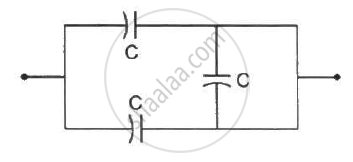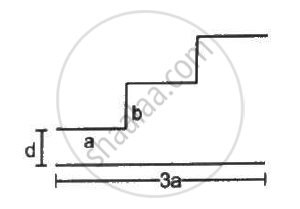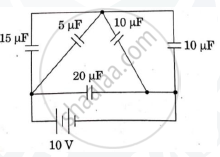Advertisements
Advertisements
प्रश्न
उत्तर
(i)

`1/C_(eqv)=1/2+1/6+1/2=7/6`
`C_(eqv)=6/7 μF`
(ii) `Q=C_(eqv)V`
`Q=6/7×7`
`Q=6 " μC"`
`E=1/2CV^2`
`E=1/2×6/7×(49)`
`E=21 J`
APPEARS IN
संबंधित प्रश्न
Define capacitor reactance. Write its S.I units.
A capacitor of unknown capacitance is connected across a battery of V volts. The charge stored in it is 360 μC. When potential across the capacitor is reduced by 120 V, the charge stored in it becomes 120 μC.
Calculate:
(i) The potential V and the unknown capacitance C.
(ii) What will be the charge stored in the capacitor, if the voltage applied had increased by 120 V?
The equivalent capacitance of the combination shown in the figure is _________ .

The outer cylinders of two cylindrical capacitors of capacitance 2⋅2 µF each, are kept in contact and the inner cylinders are connected through a wire. A battery of emf 10 V is connected as shown in figure . Find the total charge supplied by the battery to the inner cylinders.

It is required to construct a 10 µF capacitor which can be connected across a 200 V battery. Capacitors of capacitance 10 µF are available but they can withstand only 50 V. Design a combination which can yield the desired result.
A capacitor is made of a flat plate of area A and a second plate having a stair-like structure as shown in figure . The width of each stair is a and the height is b. Find the capacitance of the assembly.

The figure show a network of five capacitors connected to a 10V battery. Calculate the charge acquired by the 5μF capacitor.

Derive the expression for resultant capacitance, when the capacitor is connected in series.
The capacitance of a parallel plate capacitor is 60 µF. If the distance between the plates is tripled and area doubled then new capacitance will be ______.

